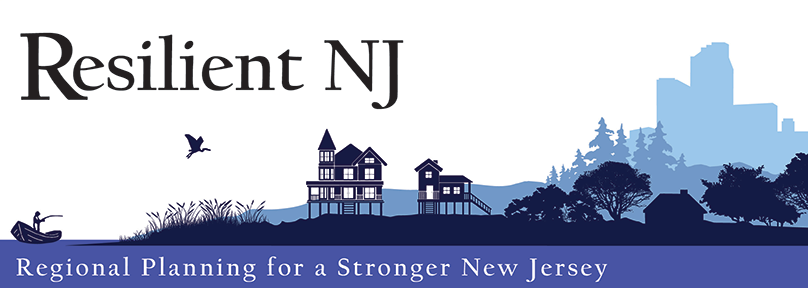New Jersey’s regional and local governments are learning how to incorporate the impacts of climate change into decisions about land use, housing, open space, and infrastructure investments. The State of New Jersey was awarded a $15 million federal grant as part of the Hurricane Sandy relief efforts in 2016. The New Jersey Department of Environmental Protection is administering $10 million for the Resilient NJ program. The remaining $5 million is being used to develop a toolkit of best practices for regional stormwater infrastructure.
Resilient NJ funds the development and implementation of four Resilience and Adaptation Action Plans for the Atlantic County Coastal, Northeastern, Raritan River and Bay, and Long Beach Island regions. For each region, municipal, non-profit, and consulting firms were awarded grants to develop their own regional plans. The regions were selected from the nine counties that were most adversely impacted by Hurricane Sandy. Each region includes three adjacent municipalities. Two of the regions, Northeastern and Raritan River and Bay, include municipalities that also have combined sewer systems and are planning substantial investments to upgrade their sewer systems.
The first phase of Resilient NJ was launched in Spring 2021 with regional planning efforts that include a strong emphasis on public input. The focus of the Spring 2021 phase was to develop a vision and priorities, while the summer focused on risks and tools. Now, the regions are working on potential solutions. Looking ahead to 2022, phase two of the program will involve another round of stakeholder engagement on Action Plan Implementation.
Addressing combined sewer overflows has been a topic of discussion in the meetings for the Northeastern region, where all of the adjacent municipalities—Bayonne, Jersey City, Newark, and Hoboken—have combined sewer systems. One participant noted in Resilient Northeastern NJ’s recently released Vision and Priorities Report that “residents in the North Ward [of Newark] are now starting to experience the effects of flooding in their community that is believed to be the result of capacity constraints of the City’s stormwater conveyance system during precipitation events as it relates to development.” Northeastern New Jersey is soliciting feedback on this report, as well as feedback on flood risks and resilience solutions. Meeting minutes and more opportunities to engage and provide feedback can be found on all four of the regional project websites.

